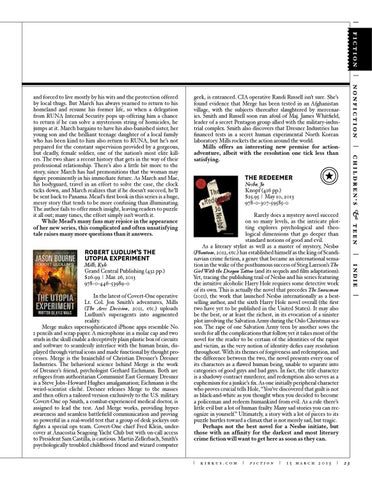and forced to live mostly by his wits and the protection offered by local thugs. But March has always yearned to return to his homeland and resume his former life, so when a delegation from RUNA Internal Security pops up offering him a chance to return if he can solve a mysterious string of homicides, he jumps at it. March bargains to have his also-banished sister, her young son and the brilliant teenage daughter of a local family who has been kind to him also return to RUNA, but he’s not prepared for the constant supervision provided by a gorgeous, but deadly, female soldier, one of the nation’s most elite killers. The two share a recent history that gets in the way of their professional relationship. There’s also a little bit more to the story, since March has had premonitions that the woman may figure prominently in his immediate future. As March and Mae, his bodyguard, travel in an effort to solve the case, the clock ticks down, and March realizes that if he doesn’t succeed, he’ll be sent back to Panama. Mead’s first book in this series is a huge, messy story that tends to be more confusing than illuminating. The author fails to offer much insight, leaving readers to puzzle it all out; many times, the effort simply isn’t worth it. While Mead’s many fans may rejoice in the appearance of her new series, this complicated and often unsatisfying tale raises many more questions than it answers.
ROBERT LUDLUM’S THE UTOPIA EXPERIMENT
Mills, Kyle Grand Central Publishing (432 pp.) $26.99 | Mar. 26, 2013 978-0-446-53989-0 In the latest of Covert-One operative Lt. Col. Jon Smith’s adventures, Mills (The Ares Decision, 2011, etc.) uploads Ludlum’s superagents into augmented reality. Merge makes supersophisticated iPhone apps resemble No. 2 pencils and scrap paper. A microphone in a molar cap and two studs in the skull enable a deceptively plain plastic box of circuits and software to seamlessly interface with the human brain, displayed through virtual icons and made functional by thought processes. Merge is the brainchild of Christian Dresner’s Dresner Industries. The behavioral science behind Merge is the work of Dresner’s friend, psychologist Gerhard Eichmann. Both are refugees from authoritarian Communist East Germany. Dresner is a Steve Jobs–Howard Hughes amalgamation; Eichmann is the weird-scientist cliché. Dresner releases Merge to the masses and then offers a tailored version exclusively to the U.S. military. Covert-One op Smith, a combat-experienced medical doctor, is assigned to lead the test. And Merge works, providing hyperawareness and seamless battlefield communication and proving so powerful in a real-world test that a group of desk jockeys outfights a special ops team. Covert-One chief Fred Klein, undercover at Anacostia Seagoing Yacht Club but with on-call access to President Sam Castilla, is cautious. Martin Zellerbach, Smith’s psychologically troubled childhood friend and wizard computer
geek, is entranced. CIA operative Randi Russell isn’t sure. She’s found evidence that Merge has been tested in an Afghanistan village, with the subjects thereafter slaughtered by mercenaries. Smith and Russell soon run afoul of Maj. James Whitfield, leader of a secret Pentagon group allied with the military-industrial complex. Smith also discovers that Dresner Industries has financed tests in a secret human experimental North Korean laboratory. Mills rockets the action around the world. Mills offers an interesting new premise for actionadventure, albeit with the resolution one tick less than satisfying.
THE REDEEMER
Nesbø, Jo Knopf (416 pp.) $25.95 | May 10, 2013 978-0-307-59585-0
Rarely does a mystery novel succeed on so many levels, as the intricate plotting explores psychological and theological dimensions that go deeper than standard notions of good and evil. As a literary stylist as well as a master of mystery, Nesbø (Phantom, 2012, etc.) has established himself as the king of Scandinavian crime fiction, a genre that became an international sensation in the wake of the posthumous success of Stieg Larrson’s The Girl With the Dragon Tattoo (and its sequels and film adaptations). Yet, tracing the publishing trail of Nesbø and his series featuring the intuitive alcoholic Harry Hole requires some detective work of its own. This is actually the novel that precedes The Snowman (2011), the work that launched Nesbø internationally as a bestselling author, and the sixth Harry Hole novel overall (the first two have yet to be published in the United States). It may also be the best, or at least the richest, in its evocation of a sinister plot involving the Salvation Army during the Oslo Christmas season. The rape of one Salvation Army teen by another sows the seeds for all the complications that follow, yet it takes most of the novel for the reader to be certain of the identities of the rapist and victim, as the very notion of identity defies easy resolution throughout. With its themes of forgiveness and redemption, and the difference between the two, the novel presents every one of its characters as a flawed human being, unable to separate into categories of good guys and bad guys. In fact, the title character is a shadowy contract murderer, and redemption also serves as a euphemism for a junkie’s fix. As one initially peripheral character who proves crucial tells Hole, “You’ve discovered that guilt is not as black-and-white as you thought when you decided to become a policeman and redeem humankind from evil. As a rule there’s little evil but a lot of human frailty. Many sad stories you can recognize in yourself.” Ultimately, a story with a lot of pieces to its puzzle hurtles toward a climax that is not merely sad, but tragic. Perhaps not the best novel for a Nesbø initiate, but those with an affinity for the darkest and most literary crime fiction will want to get here as soon as they can.
|
kirkus.com
|
fiction
|
15 march 2013
|
23
